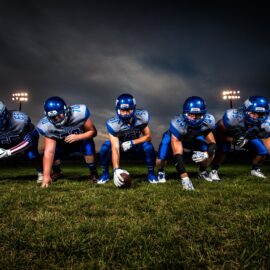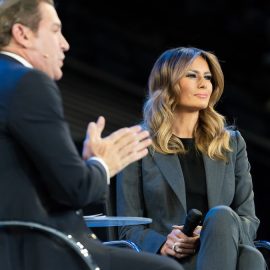

This article is an excerpt from the Shortform book guide to "The Blind Side" by Michael Lewis. Shortform has the world's best summaries and analyses of books you should be reading.
Like this article? Sign up for a free trial here .
Where did Michael Oher go to college? How did Michael Oher’s college football career go?
For Michael Oher, college was once an unattainable dream. But that changed when he met the Tuohy family and began on his journey to play college football.
Read more about Michael Oher, college, and his time at Ole Miss.
Michael Oher: College and Big Man on Campus
Michael’s freshman year at Ole Miss was not what he or the Tuohys expected. Despite Coach O’s insistence that Michael would start at left tackle, the offensive lineman coach, George DeLeone, had different ideas. In his 36 years coaching at the collegiate level, he’d only started a freshman once. He believed Michael should red-shirt―when new players practice but don’t play or lose a year of eligibility―like all other freshmen and learn the ropes. He didn’t think he should be driving up to Memphis before the season to teach Michael the offensive plays using Leigh Anne’s dining chairs as props. But that’s what he did, and it seemed to be working. Michael’s lesson only stopped when Leigh Anne came home and was displeased to see her $2,000 chairs being run off the line by her giant son.
DeLeone still didn’t want to play Michael, but he did what his head coach asked with a small modification. Michael would not start at left tackle, but at right guard, which was flanked by other linemen who could help guide Michael on the field. The only problem was that the rest of the offensive line was made up of big, slow players who were just as confused by the plays as Michael was.
Many of the Ole Miss players were also inner-city black kids with little education or critical-thinking skills. DeLeone’s plays were vast and complicated, and the team never got the hang of them. Often, they would run in the wrong direction on the field or misunderstand which play was being called. By the final game of the season, Ole Miss had a 3-7 record and little confidence in their ability to win. Their offense was the worst in the conference, and they ranked 115th in the country of 117 Division I football programs.
It seemed as though things couldn’t get worse for the Rebels, but their final game was more important than any game of the year. They were playing in-state rivals, Mississippi State, a school considered the headquarters of redneck nation and stuck in the old South. Compared to the wealthy and seemingly tolerant Ole Miss, they were the lowly working-class school. And the two teams hated each other.
The rivalry game was called the Egg Bowl because of the egg-shaped trophy passed back and forth depending on who won the game. Ole Miss hadn’t lost the game in more than four years, and they didn’t want to start now. It would not only be an embarrassment in front of the rival crowd. It would be national humiliation. And it would also mean death for the offensive coaches, especially DeLeone.
For Michael’s part, he did his best to follow the plays and support his team. He mostly caught on and performed exceedingly well in his new position. But he also struggled and was lost and confused on the field during play. Usually, his good games came after hours of extra practice with Sean, who ran through all the plays with Michael beforehand. Playing in the SEC was a far cry from the three-play offense at Briarcrest, and an error meant more than simply an open player. It was the difference between the quarterback walking off the field or being carried off the field. The pressure was high, and it was intensified for this final game.
The embarrassment started immediately and swiftly. The inability of the Ole Miss offensive coaching squad to come up with a strategy that could harness the low skills of their players was no more apparent than that day. They ran the same plays over and over again, swapping players out rather than changing strategies. When Michael and two other linemen all defended the same player in the third quarter, Michael was yanked from the game and rode the bench for the remainder. He watched the rest of his first college season go down the drain with a 14-35 loss, and from the stands, Leigh Anne and Sean were already plotting to rectify this situation.
Rising to the Challenge
The terrible season at Ole Miss did little to decrease the excitement surrounding Michael. He’d done enough during those games where he understood what was happening and performed well, and the accolades came flooding in during the postseason. He was named First-Team Freshman All-American and All-SEC. He was considered the best offensive player on the team and received national attention in sports publications. It seemed there was nothing in Michael Oher’s college career that could do wrong.
Sean and Leigh Anne recognized that Michael’s rising status meant he was more beneficial to the Ole Miss team than they were to him. They used that as leverage with Coach O, threatening to transfer Michael if the entire offensive coaching staff wasn’t fired. Whether it was this threat or common sense, Coach O fired the staff and went in search of new coaches and new talent.
Michael started to feel an obligation to appease all of the people who had so much faith in him. He didn’t want to ride on his laurels as a great prospect. He wanted to be a great player. He started to apply himself to his training, including spending hours in the weight room during the offseason. By the start of his sophomore year, Michael had sculpted his body into a lean machine. He could bench press 400 pounds now, a massive jump from the 225 he started with. And he’d dropped 24 pounds and turned his flesh into muscle.
His prospects for the new season were high, and Coach O had decided that he would play nothing other than left tackle, as he should have been playing all along. His future seemed bright and shiny as ever if he could stay out of trouble.
The Problem With Michael Oher in College
Michael may have left home for college, but he never truly moved into a new life. His tutor, Sue, followed him to Ole Miss, Collins was a cheerleader for the football team, Hugh Freeze was still his coach (having moved to Ole Miss from Tennessee after Michael enrolled), and the Tuohys often stayed in their new home only a few blocks from campus. Not much had changed in his life except his location. For Michael Oher, college hadn’t changed much.
Michael’s character also didn’t change. He had a bit more swagger now from all the press he was receiving, but he was still quiet and shy. He didn’t hang out with the other football players much. Michael sometimes brought players home to Memphis for dinner, but for the most part, he kept to himself.
Part of the problem was that Michael had one foot in both the white crowd and black crowd at Ole Miss, which was different than at Briarcrest. He’d been removed from his old world by a racial border in Memphis, and he’d worked so hard to graduate, he’d rarely had time for much else. But now, Michael was surrounded by others who’d grown up in similar poor black neighborhoods as he did as a boy, and that part of him was sprouting to life again.
He started going back to his old neighborhood more and more, and trouble often followed. For instance, he was handcuffed on one visit to see his mother when the police arrested her for driving a truck owned by a man whose dead body had recently surfaced. Michael called Sean from jail, and Sean cleared the mess up. But he explained to Michael that the police were likely to treat him differently because he was black, and he needed to show them respect.
Sue was also caught up in this part of Michael’s life. She was now tutoring several of Michael’s black teammates, much to his chagrin. He grew jealous of her relationship with one friend and accused her of loving the other player more than him.
Leigh Anne tried to keep a close eye on Michael. She accepted his friends’ criminal histories or poor upbringings, but she also told Michael if he got into any trouble, her wrath would outweigh any other consequence. She did her best to keep Michael on the straight and narrow, but even the great Leigh Anne Tuohy couldn’t stop Michael’s innate child-like behavior.
For Michael Oher, college was a chance to get an education and pursue football. But it also allowed him to hang on to his life with the Tuohys.

———End of Preview———
Like what you just read? Read the rest of the world's best book summary and analysis of Michael Lewis's "The Blind Side" at Shortform .
Here's what you'll find in our full The Blind Side summary :
- How Michael Oher went from the projects in Memphis to the NFL
- Why the combination of size and speed became essential for football stars
- How Oher was taken in by the wealthy Tuohy family






